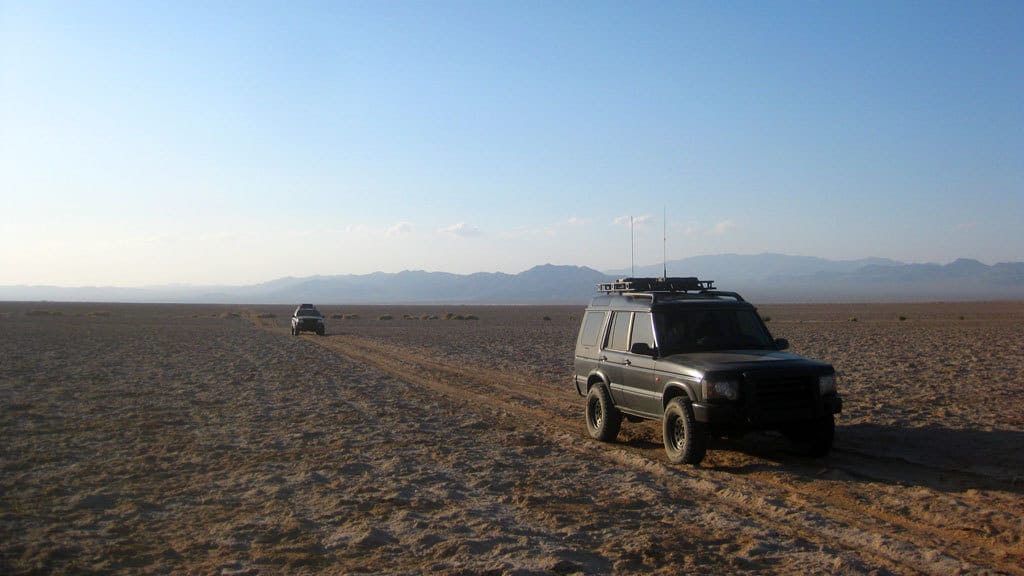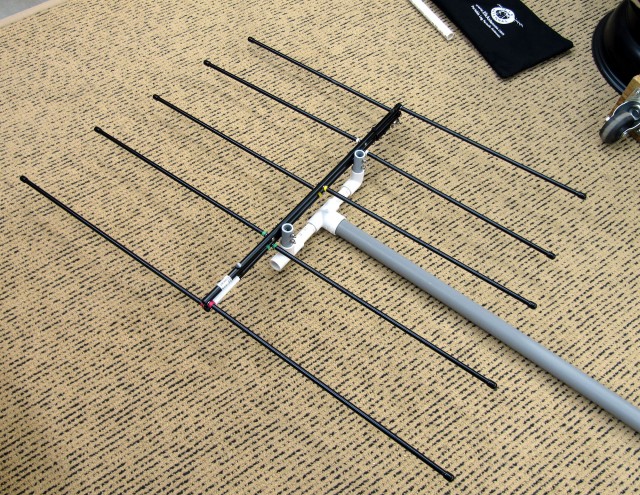There’s always someone in the crowd that makes this statement whenever there is a discussion about communications in the field. It usually happens right after someone brings up amateur radio (HAM). Ignorant as this statement may be, the fact remains: most of us really don’t want to talk to China.
Let’s Face It: CB is Terrible
The good ole Citizen’s Band radio has poor range, limited power, and terrible clarity even after considerable time, effort, and money have been poured into “tuning” a CB setup. More often than not they are big and ugly, and the few decent-looking models are expensive. If the setup is kept 100% legal, you’ll be lucky to talk over 5 miles—if there are no trees in the way. The common consumer FRS/GMRS two-way radios don’t perform much better, and almost none of them allow for a vehicle mounted antenna (essentially trapping the signal inside a metal box). It’s time for something better.
Though I sit alone in a concrete-walled building, I can already hear the grumblings of my fellow HAMs. I’m going to say it anyhow: For the average, non-technical, backcountry traveler wanting for communications that just work, HAM really is “just like CB, only better.” This article is intended for the CB’er and FRS’er that simply wants performance and reliability in the backcountry, and is merely an overview on achieving that goal. I’m going to skip over the few rules, regulations, and etiquette that should be followed as these will be covered in your learning when you study for your license. Fear not, for the most part it’s simple common sense. The best place to learn and practice is with a group of fellow amateurs—check out our Communications forum or search the ARRL Club Directory to find one near you.
What You’ll Need
Amateur Radio License
Fortunately, the FCC agrees with the need we have for better radios regardless of technical experience or interest. They have dropped the “difficult” portions from the Technician exam (the most basic level of amateur radio license), and a license can be picked up today for $15 and a few hours of effort (including study time). With the license, you will gain access to the two most important frequency bands: 2-meter and 70-cm (often referred to as 440). Study guides and practice exams can be found here: HamExam.org. When you’re ready to pass the test you can find an exam session here: ARRL Exam Search.
Amateur Radio Equipment
With licensing out of the way, it’s time to purchase a radio. The multitude of complicated equipment options are often overwhelming to the newly licensed HAM, but it’s much easier than it looks to put together a good radio setup. In fact, it often far easier than getting a CB working properly.
I mentioned two frequency bands in the previous section: 2-meter and 70-cm. 2-meter is by far the most popular frequency band, and provides good range and clarity in most situations. In canyons and hilly terrain, 70-cm provides a small but noticeable improvement over 2-meter. Unfortunately, it doesn’t get used nearly as often during group outings, but I still feel it’s worth the extra cost to have.
You may notice that the handhelds recommended below transmit at five watts, essentially the same as a CB radio. The difference is in the way the amateur radio frequencies work, which allows the signal to carry much farther with much less power—a mere 5-watt handheld can easily reach out over dozens of miles. With a good antenna and transmitting location, the larger mobile radios can provide communications across hundreds of miles.
Handheld Options
I am admittedly biased towards Yaesu’s handheld radios (HTs). While there are other good options out there, simplicity, ease of use, and reliability continue to earn them one of the best reputations in the industry. The antennas Yaesu includes with their radios are excellent, so they can simply be unscrewed from the unit and placed on an external vehicle mount to increase range without significantly increasing cost.
The Budget Setup: Yaesu FT-270R, $150
The FT-270R is a reasonably inexpensive, ruggedized radio able to shrug off dust and water (submersible). It’s also simple and easy to operate, though will only provide access to the 2-meter band.
Recommended Accessories: Yaesu Waterproof Microphone (MH-73A4B, $42); MFJ Handheld Antenna Window Mount (MFJ-310S, $18) or Diamond Mini Dual-band Mobile Antenna w/magnetic mount (MR77SMA, $33); Yaesu 12VDC Power Adapter (E-DC-5B, $24); Yaesu Programming Kit, allows easy programing from a Windows PC (ADMS-270, $37)
Performance and Versatility: Yaesu VX-7R, $355
Yaesu’s VX-7R is equally rugged, but is smaller, lighter, runs on longer-life Li-Ion batteries, and adds the additional functionality of the 70-cm band. While these improvements come with an increased price, it’s well worth it if you are going to be carrying your radio frequently or will need the superior performance of the 70cm band while traveling through hilly terrain. It’s also capable of simultaneously running on two different frequencies, which comes in handy for using a repeater while continuing to monitor your group’s communications.
Recommended Accessories: Yaesu Waterproof Microphone (MH-73A4B, $42); MFJ Handheld Antenna Window Mount (MFJ-310S, $18) or Diamond Mini Dual-band Mobile Antenna w/magnetic mount (MR77SMA, $33); Yaesu 12VDC Power Adapter (E-DC-5B, $24); Yaesu Programming Kit, allows easy programing from a Windows PC (ADMS-1G, $37)
Vehicle Mounted Options
Moving up to a larger, vehicle-mounted radio provides substantial improvements in both range and clarity over a handheld unit. Most mobile radios start out at 50 watts, literally ten times the power output of the typical handheld. The downside, of course, is being tied to the vehicle.
The Budget Setup: Yaesu FT-1900R, $140
Yaesu’s FT-1900R is essentially the same ruggedized radio as the FT-270R mentioned earlier, but in a higher powered (50 watts), mobile package. See below for antenna recommendations.
Recommended Accessories: Yaesu Programming Kit, allows easy programing from a Windows PC (ADMS-1900, $37)
Performance and Versatility: Yaesu FT-8800R, $403
Like the VX-7R, the FT-8800R’s larger price tag offers significantly improved functionality. Both the 70cm band and dual-tranciever features are present, as well as a remote-mountable face for easy installation. This mobile radio is also capable of cross-band repeating, which allows you to extend the range of a handheld radio while outside the vehicle by using it as a mobile repeater. Note: the FT-8800R, while plenty durable, is not a ruggedized radio.
Recommended Accessories: Yaesu Programming Kit, allows easy programing from a Windows PC (ADMS-21, $37)
Antenna Options:
If you’re shy about drilling holes in your vehicle, rest easy—there are perfectly suitable, magnetic-mount antennas available for amateur radio. Diamond is reasonably priced, and manufactures arguably the best 2-meter/70-cm antennas on the market. Their dual-band mini magnet mount antenna (Diamond MR77, $34) is ideal for an easily removable solution. For a more permanent setup, the NR73 NMO (Diamond NR73BNMO, $47) is an excellent choice, mated with either Diamond’s NMO base kit (Diamond C213SNMO, $40) or heavy duty trunk/hatch mount (Diamond K400SNMO, $70). In most situations, these setups will not require any tuning after installation.
Reaching Even Farther
Solid group communications is enough of a reason in itself to hop on the amateur radio bandwagon, but it comes with another great feature: wide-spread repeater coverage. Repeaters are amateur radio stations which receive your transmission, and simultaneously re-transmit it at high power over a large area. As a result, you’re able to communicate with others over far greater distances than you would with the radio alone. Additionally, many cell phone “dead zones” in the backcountry have excellent repeater coverage, putting assistance close at hand. The ARRL publishes a directory of repeaters every year, which can be purchased for around $11 (ARRL Repeater Directory 2012-2013). It’s also a good idea to search online for the popular repeaters in an area you plan to visit before your trip.
While the radio setups mentioned above will provide excellent coverage for most purposes, our travels often take us to extremely remote locations where repeater access by “conventional” means may be impossible. High frequency (HF) is undeniably the best option for these situations, but it requires an additional level of learning, licensing and an investment in radio equipment that can quickly reach thousands of dollars. A good compromise is to add a directional antenna to your emergency kit, which can be hooked up to your radio to significantly boost it’s range and increase the odds of getting your transmission heard. As the name implies, you’ll need to know at least the general direction of the person or repeater you’re trying to reach to successfully use this type of antenna. Elk Antennas produces an excellent compact antenna (Elk Model 2M/440L5, $125), and a convenient carry bag to store it in (Elk Bag, $25).
Beyond the Basics
As mentioned earlier, this article is intended merely as a practical approach to a good field communications setup for the non-technical backcountry traveler. For those wanting more, the possibilities are endless. Everything from live-tracking a group on a moving map to sending an email 100 miles from the nearest hotspot is possible—yes, even talking to China. The only limitation is how much you want to learn.





